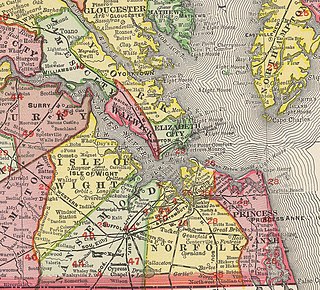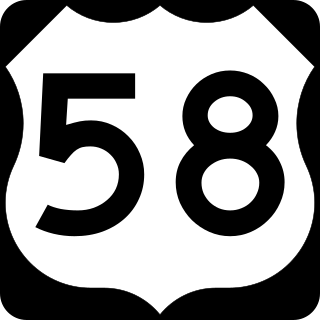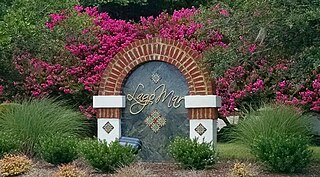Related Research Articles

Virginia Beach is an independent city located on the southeastern coast in the Commonwealth of Virginia in the United States. The population was 459,470 at the 2020 census. Although mostly suburban in character, it is the most populous city in Virginia, fifth-most populous city in the Mid-Atlantic, ninth-most populous city in the Southeast and the 42nd-most populous city in the U.S. Located on the Atlantic Ocean at the mouth of the Chesapeake Bay, Virginia Beach is the largest city in the Hampton Roads metropolitan area which includes 6 other cities. This area, known as "America's First Region", also includes the independent cities of Chesapeake, Hampton, Newport News, Norfolk, Portsmouth, and Suffolk, as well as other smaller cities, counties, and towns of Hampton Roads.

County of Princess Anne is a former county in the British Colony of Virginia and the Commonwealth of Virginia in the United States, first incorporated in 1691. The county was merged into the city of Virginia Beach on January 1, 1963, ceasing to exist.

The United States Life-Saving Service was a United States government agency that grew out of private and local humanitarian efforts to save the lives of shipwrecked mariners and passengers. It began in 1848 and ultimately merged with the Revenue Cutter Service to form the United States Coast Guard in 1915.
The Norwegian Lady Statues are located in the sister cities of Moss, a coastal town and municipality in the county of Østfold, Norway, and at the Oceanfront (boardwalk) in the coastal resort city of Virginia Beach, Virginia in the United States. They commemorate the lives lost in the 1891 shipwreck of the Norwegian barque Dictator off the coast of Virginia Beach and the lifesaving efforts of the community.

The Virginia Beach Surf & Rescue Museum honors and preserves the history of Virginia's maritime heritage, coastal communities, the United States Lifesaving Service, and the United States Coast Guard along the Atlantic coast.
Pembroke Manor is an area in the independent city of Virginia Beach, Virginia, United States located around the intersections of Virginia Beach Boulevard and Independence Boulevard. The community's name comes from Pembroke Manor, a plantation built in 1764. The house was donated by the Aragona family to the Princess Anne Historical Society, but currently is under private ownership and serves as Ivy League Academy, a private Christian school for children K4 through 5th grades. The structure itself was placed on the National Register of Historic Places in 1970 as #70000887 and is one of the oldest and most significant structures in the City of Virginia Beach.

Sandbridge, in the U.S. state of Virginia, is a coastal community of Virginia Beach, located along the coastline on the Currituck Banks Peninsula at the northern end of the Outer Banks. The Atlantic Ocean is to the east, the Back Bay of the Currituck Sound is to the west, and the Back Bay National Wildlife Refuge and False Cape State Park lie to the south. To the north, Sandbridge borders the U.S. Navy's Dam Neck facility. Located near the southern end of Sandbridge is Little Island Park, which is managed by the City of Virginia Beach. Sandbridge Beach runs approximately 4.5 miles from north to south along the oceanfront.

Virginia Beach Boulevard is a major connector highway which carries U.S. Route 58 most of its length and extends from the downtown area of Norfolk to the Oceanfront area of Virginia Beach, passing through the newly developed New Urbanist Town Center development of the latter as it links the two independent cities in the South Hampton Roads subregion of the Hampton Roads region in southeastern Virginia.
Thalia is a residential neighborhood in the northeastern area of the independent city of Virginia Beach in the Hampton Roads region of Virginia.

The history of Virginia Beach, Virginia, goes back to the Native Americans who lived in the area for thousands of years before the English colonists landed at Cape Henry in April 1607 and established their first permanent settlement at Jamestown a few weeks later. The Colonial Virginia period extended until 1776 and the American Revolution, and the area has been part of the Commonwealth of Virginia ever since.
Kempsville is a borough in the City of Virginia Beach, Virginia, a historic section with origins in US colonial times located in the former Princess Anne County. In modern times, it is a community within the urbanized portion of the independent city of Virginia Beach, the largest city in Virginia.
The Norfolk, Virginia Beach and Southern Railroad was a 19th-century railroad that operated a line from downtown Norfolk to the Virginia Beach oceanfront, where the railroad owned and operated the Princess Anne Hotel. A branch split southeast from the present day Newtown Rd area and proceeded into Princess Anne county following the route of today's Princess Anne Road. The branch terminated at Munden where the railroad operated a turntable as well as two steam ferries. The Munden site is now Munden Point park of the City of Virginia Beach Parks and Recreation. Only the wharves remain of this early intermodal operation.

The history of Norfolk, Virginia as a modern settlement begins in 1636. The city formally was incorporated in 1736. The city was burned by orders of the outgoing Virginia governor Lord Dunmore in 1776 during the second year of the American Revolutionary War (1775–1783), although it was soon rebuilt.

Virginia Beach Public Library (VBPL), located in Virginia Beach, Virginia is a comprehensive library system serving Virginia Beach, an independent city with a population of 450,000 in the Hampton Roads metropolitan area of Virginia. The library supports the educational and leisure needs of citizens with a system of area libraries, a bookmobile, a virtual library, the Wahab Public Law Library, the Municipal Reference Library, and the Library and Resource Center for the Blind and Visually Impaired (DBVI). The collection contains more than 1 million print and non-print items.
Virginia Beach, Virginia is a city that has become a popular tourist destination in recent years on account of its historical, scientific, and performing arts.

Lago Mar is a neighborhood on the north end of the Currituck Sound in the Princess Anne area of southeastern Virginia Beach, Virginia, United States. The name translated from Spanish to English means "lake" and "sea". It is derived from its proximity to the Atlantic Ocean and Brinson's Inlet Lake, as well as from the neighboring community of Ocean Lakes. The street names within Lago Mar are also of Spanish origin with the notable exception of Atwoodtown, which is what the area was called prior to being renamed in the 1960s. Today, neighboring communities Ashby's Bridge, Lotus Creek, Mirasol, Parkway Estates, and parts of Sigma are sometimes included in greater Lago Mar, especially for real estate marketing or demographic purposes.
Barnett Karl Thoroughgood was an African-American Holiness Pentecostal minister and church leader of the Church of God in Christ. He was an influential pastor in the city of Virginia Beach, Virginia, and the Hampton Roads area of Virginia known for his public service and who served as the Commissioner of Ecclesiastical Services and the Former Adjutant General of the COGIC denomination from 2001 until his death in 2012.

This is a list of United States Coast Guard historical and heritage sites that are open to the public. This list includes National Historic Landmarks (NHL), the National Register of Historic Places (NRHP), cutters, museums, monuments, memorials and more. It includes only NHL Lighthouses. There are many more resources dedicated to lighthouses, this list attempts to collect everything else in one list. The United States Lighthouse Society, Lighthouse Friends and the many Wikipedia pages dedicated lighthouses are a few of the many excellent resources for those interested in lighthouses. This list captures the most important historical features, that is the NHL and the often overlooked U.S. Coast Guard sites.
References
- 1 2 3 4 www.seatackcivic.org/History.html
- 1 2 3 Virginian-Pilot, The. "Virginia Beach center named for community leader". pilotonline.com. Retrieved 2019-12-11.
- 1 2 3 4 Skelton, Alissa. ""Eventually, Seatack will be gone": Residents worry historic black community in Virginia Beach is disappearing". pilotonline.com. Retrieved 2019-12-11.
- 1 2 3 C-SPAN Cities Tour - Virginia Beach: Seatack Resident Sadie Shaw on Challenges Growing Up, archived from the original on 2021-12-21, retrieved 2019-12-11
- ↑ Virginian-Pilot, The. "Beach behemoth had modest start a century ago". pilotonline.com. Retrieved 2019-12-11.
- ↑ Purvis, Laura (December 2018). "HISTORIC ARCHITECTURAL RESOURCE SURVEY AND HISTORY OF VIRGINIA BEACH UPDATE OF THE CITY OF VIRGINIA BEACH, VIRGINIA" (PDF). Historic Preservation Commission, Department of Planning and Community Development, Commonwealth of Virginia, in Partnership with the Virginian Pilot: 168.
- ↑ rachel (2016-03-08). "Did You Know These Celebrities Grew Up In Virginia Beach?". Virginia Beach. Retrieved 2019-12-11.
Books
- William O. Foss The Norwegian Lady and the Wreck of the Dictator. Virginia Beach, Virginia: Noreg Books, 2002. ISBN 0-9721989-0-3.